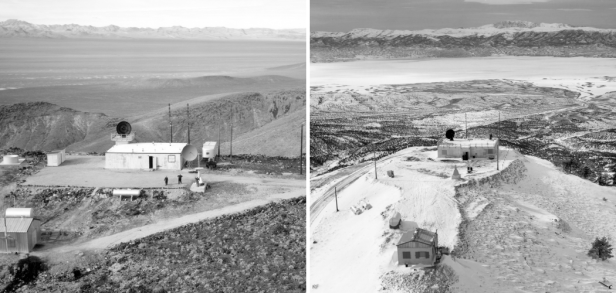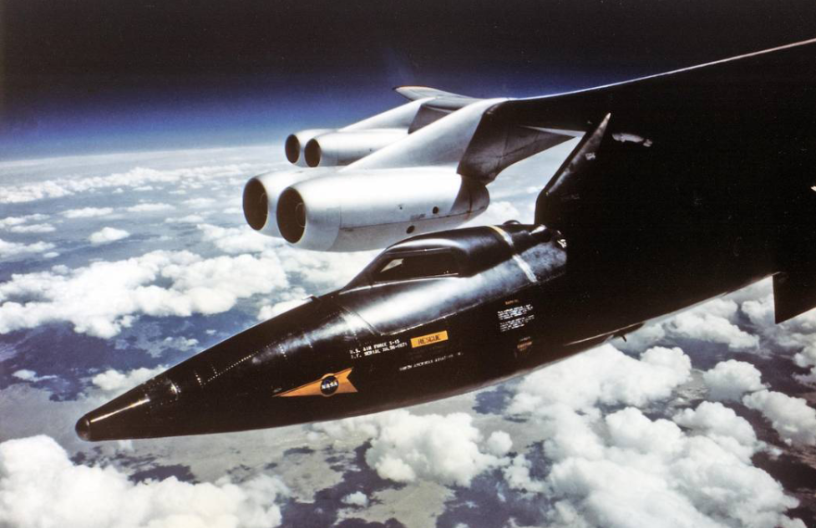By any measure the North American X-15 was an amazing aircraft. By the end of the decade long, 199 flight programme the three aircraft had pushed airspeed and altitude records way beyond all previous marks. Many X-15 pilots qualified as astronauts on their high altitude flights and the wealth of operational knowledge that was gained continues to influence aerospace programmes to this day.
Yet for all this, the X-15 is often overshadowed by NASA’s other activities during the 1960s and its legacy overlooked. It could never go as high or as fast as the capsules launched from the Cape, but the fact remains, at the time it was designed the X-15 looked like it would provide America’s first forays in human spaceflight and as Tom Wolfe points out in The Right Stuff, they would FLY their vehicle there and back.
Mach 1 and beyond
The story of the X-15 really starts as an extension of the high speed research programs being carried out by the NACA, Air Force and Navy beginning at the end of World War 2. Following the advent of effective liquid-fuelled rocket propulsion, the development of the jet engine and advances in aerodynamics during that conflict, it became clear that aviation would be pushing into new flight regimes. Famously the Bell X-1 (originally the XS-1) marked the first in a long line of experimental aircraft constructed to explore these new regimes and gather data which could later be applied to the design of operational aircraft.

The much delayed Bell X-2 was anticipated to provide valuable data in these areas, but this troubled aircraft didn’t manage to make its first powered flight until 1955. On September 7th 1956, Air Force pilot Iven Kincheloe took the X-2 to a new altitude record of 126,200ft and it looked like the X-2 might start to make good on its promise, but on the very next flight just 20 days later, Milburn Apt was killed after reaching a speed in excess of Mach 3. Apt had fallen victim to a high speed aerodynamic phenomenon known as inertia coupling, where the aircraft’s control surfaces lose their ability to counteract the inertia of the fuselage resulting in a loss of control and tumbling in all three axis. Chuck Yeager had managed to survive an encounter with inertia coupling after he exceeded Mach 2.5 in the X-1A, but although Apt was able to recover control and separate the X-2s escape capsule, he became incapacitated and was unable to parachute to safety.
Although the X-2 had provided some data on high altitude flight and aerodynamic heating it was clear that much work remained for the next planned research vehicle.
Genesis of the X-15
As early as 1952, discussions had begun on the need for a research aircraft capable of reaching hypersonic velocities (exceeding Mach 5) and altitudes in excess of 50 miles. Initial ideas included an adapted X-2, but it quickly became clear that a new design would be required. By 1954 the NACA Langley facility created a baseline design for a hypersonic research plane which was able to include revised control surfaces to help counter inertia coupling. Concurrently the Office of Naval Research had been working with Douglas aircraft on a concept for a vehicle of broadly similar capabilities as a successor to the D-558-2. Although both their concept, known as the Model 671, and the proposed Langley vehicle had many unknown in terms of materials and propulsion, there was sufficient agreement from the NACA, Air Force and Navy that such a vehicle was technically feasible. In October 1954 a memorandum of understanding was signed by all three parties and Project 1226, soon to be given the new designation X-15, began in earnest.
Before the end of 1954, an invitation to bid was circulated to 12 prospective airframe contractors for three vehicles. Each contractor was obliged to specify their preferred power plant from a separate list. On May 9th 1955 proposals from Bell, Douglas, North American Aviation (NAA) and Republic were received and between them they represented a variety of approaches to meeting the specification. On paper it could be imagined that both Bell and Douglas would have an advantage given their previous experience with high speed research vehicles. This was new ground for NAA and Republic although both companies had gained substantial experience on contemporary supersonic fighter and interceptor projects by this time.
Each proposal had it’s relative strengths and weaknesses and independent evaluations were carried out by the NACA, Air Force and Navy. As well as specifying their engine choice and how they proposed to cope with the thermal and aerodynamic challenges, all four proposals also had to offer alternative two-person configurations for their airframe to allow for an observer or primate to fly – a feature never used (probably fortunately given some of the solutions proposed).

The winning design

NAA now entered the detailed design and construction phase which lasted 3 years with some 2 million man-hours dedicated to engineering and over 4,000 hours of wind tunnel testing. One key asset the contractor had on their side through this process was test pilot Scott Crossfield. Having become the first man to exceed Mach 2.0 in the Douglas Skyrocket, Crossfield had chosen to resign from the NACA to help NAA push through the development of the X-15 figuring his experience of piloting high speed rocket planes could prove invaluable.

The other major change to the aircraft during this period was the switch from the XLR30 engine to the more powerful and controllable XLR99. While this engine offered significant performance improvements, it was dogged by developmental problems and consequently massive cost overruns. Initially priced at just under $10 million, the XLR99 eventually came in at a colossal $68 million – to put this in context this total was more than 5 times the originally projected cost of the entire X-15 programme!

With regards to air-launching the X-15, the decision was made to change from the B-36 based on its lack of performance in terms of speed and altitude and concerns at Edwards over its practicality from a maintenance perspective (the B-36 was in the process of being phased out by SAC by this time meaning the competency of service crews and availability of parts would only diminish during the expected programme lifetime). The SAC’s new supersonic Convair B-58 Hustler was considered, but was found to be ill-suited as the X-15’s relative size meant the bomber’s nose wheel could not have deployed. A better fit was the Boeing B-52 although this meant the X-15 would need to be mated to a pylon inboard of the first set of engines. While tests proved this solution was feasible it did mean that unlike on earlier air-launched research planes, the pilot would need to enter the X-15 prior to takeoff and, should an emergency occur, be jettisoned along with the rocket plane to fend for himself.
Preparations for flight

Crossfield had also been working hard on the Human Factors side of the project including the development of the MC-2 pressure suit by the David Clark Company and setting initial flight profile parameters via simulator runs in the centrifuge at the Navy’s Johnsville facility. The extensive use of simulators was a key development during the X-15 programme, initially for pilot training but also as an integral part of mission planning. Before flight testing began, a variety of simulators were constructed NAA’s Inglewood plant, the Flight Research Centre at Edwards and Johnsville.
The X-15 would present a number of new challenges for its pilots ranging from flying in a full pressure suit in the pressurised nitrogen cockpit environment to using both aerodynamic and reaction controls during different phases of the flight. As well as a regular centre stick, the cockpit featured sidestick controllers to help the pilots under high positive (during the boost phase) or negative (during reentry/pull-up) G conditions.

The High Range and Control Room



By October 1958 the first X-15 was completed and ready for rollout, but it entered a very different world to the one in which it had originally been conceived. In the years since the programme had been initiated, ideas of human spaceflight had gone from being somewhat remote to a matter of some national urgency.

Early in October 1958, NASA had announced Project Mercury with the aim of placing a manned capsule in space atop a missile. While for many within the industry, especially those who had been involved with high speed flight and the X-Planes, Mercury seemed somewhat inferior to a piloted spaceplane. Some of the X-15’s thunder had been stolen by the time it rolled out from NAA’s Inglewood plant on October 15th, but the X-15 had never been primarily about placing a person in space. It had a job to do gathering data on high speed high altitude flight and now it was almost ready to get started. Referring to the trip into the unknown that lay ahead of the three X-15s Walter Cronkite commented “They might be appropriately called the Nina, Pinta and the Santa Maria”. Then Vice President Richard Nixon simply stated that, in his career “…there will be no day more exciting than this”
Read Part 2 of this article: Riding the Bull
Sources
At the Edge of Space – Milton O Thompson
Illustrated History of Space Shuttle: US Winged Spacecraft X-15 to Orbiter – Melvyn Smith
The X-Planes: X-1 to X-45 – Jay Miller
Hypersonic: The story of the North American X-15 – Dennis R. Jenkins & Tony R. Landis
The X-15 Rocket Plane: Flying the First Wings into Space – Michelle Evans
The Right Stuff – Tom Wolfe
X-15: Extending the Frontiers of Flight – Dennis R. Jenkins
Hypersonic Before the Shuttle: A Concise History of the X-15 Research Airplane – Dennis R. Jenkins


SUCH a sexy design was the ol’ X15. The shot of the various “supermodels” at Edwards is a bit of a pinup too. The sci-fi future at that point was as stylish as it ever got, modelled off these babies.
LikeLike